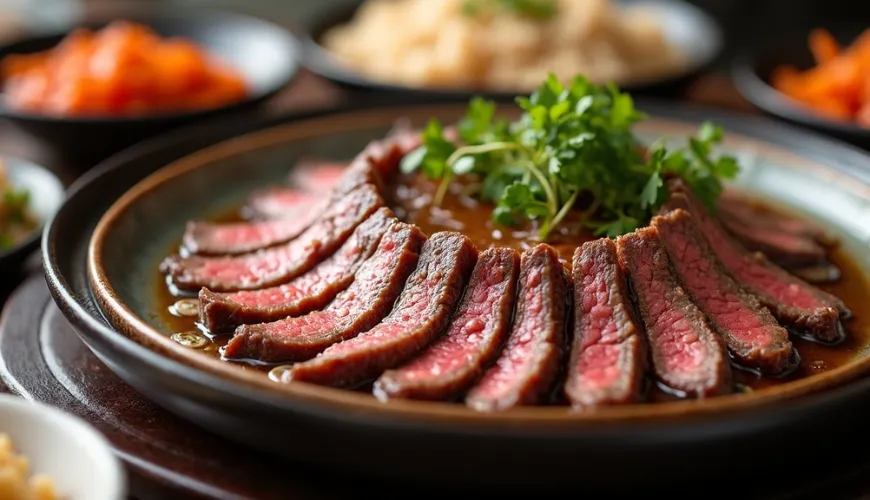
How to Enjoy Bulgogi at Home and Impress Your Loved Ones

What is Bulgogi and Why the World Has Fallen in Love with It
At first glance, it looks modest – thin slices of beef marinated in sauce, briefly fried in a pan. But once you take a bite, you understand why Korean bulgogi is conquering culinary worlds not only in Asia but also in Europe. This dish, whose name literally means "fire meat," is not just about taste – it's a demonstration of how culture, tradition, and a love for quality ingredients can come together in a single bowl.
Korean bulgogi has a rich history dating back to the Goguryeo period (37 BC – 668 AD), where similar recipes were prepared under the name maekjeok. Although the version of the time was cooked on a skewer, the principle remains the same – quality meat marinated in a sweet-salty sauce, quickly prepared and served with rice, vegetables, or in a sandwich. In modern Korean cuisine, bulgogi is considered a dish for special occasions, but due to its simplicity, it is becoming increasingly popular as an everyday dinner.
The Secret of the Taste? Bulgogi Sauce
The basic recipe for bulgogi stands and falls with the marinade. It is the bulgogi sauce that gives the meat its distinctive flavor – mildly sweet, salty, with notes of garlic, sesame oil, and fermented soy sauce. The key is the balance of flavors, not spiciness – unlike other Korean dishes, beef bulgogi is not spicy, making it an ideal entry point for those new to Korean cuisine.
Traditional bulgogi sauce consists of soy sauce, sugar (or honey), sesame oil, garlic, spring onions, ground ginger, and often pear puree, specifically from a Korean pear. It adds not only a gentle sweetness but also enzymes that naturally tenderize the meat. If you don't have a Korean pear, an apple or regular European pear will be a great substitute.
For those who love quick preparation, there are also ready-made versions of bulgogi sauces available at health food stores or Asian food e-shops. However, the homemade version with fresh ingredients has an unmistakable strength and aroma.
How to Prepare Homemade Beef Bulgogi
If you decide to try the bulgogi recipe at home, the good news is that you don't need any special equipment or exotic techniques. On the contrary – the recipe is so flexible that it can be adjusted according to available ingredients and dietary preferences.
The most common choice is beef, specifically cuts like sirloin, tenderloin tip, or flank. It's important to cut the meat as thinly as possible, ideally across the grain, to make it as tender as possible. Some chefs freeze the meat before slicing to make it easier to cut. Then it is marinated for at least an hour, but preferably overnight.
After marinating, it's time for quick heat treatment – the meat is fried in a hot pan with a bit of oil or grilled on an electric or classic grill. It's important not to overcrowd the meat and cook it in batches so it doesn't steam in its own juices.
Side dishes are an integral part of the experience. The classic is white rice, lettuce leaves (such as Romaine or butter lettuce) in which you can wrap the meat and accompaniments, and of course, fermented vegetables – kimchi, which adds freshness and probiotics to the dish.
Vegetarian and Modern Variations
And what if you don't eat meat? Bulgogi has plenty to offer here as well. In Korea, versions with tofu, mushrooms (especially shiitake or oyster mushrooms), or even tempeh are commonly prepared. The marinade remains the same, only the marinating time and preparation method are adjusted.
In world cuisines, bulgogi is starting to appear in untraditional forms – as a filling for tacos, in a hamburger (known as a bulgogi burger), or even as a pizza topping. An interesting example is a New York restaurant offering bulgogi wraps with fresh vegetables in a tortilla – the ideal fusion of East and West.
Why Enjoy Bulgogi at Home?
Besides its exceptional taste, bulgogi has other benefits. Thanks to the preparation from thin slices of meat and short heat treatment, the meat retains a high nutritional value, especially proteins and iron. If you use less sugar or replace it with alternatives, it can be a light and balanced meal suitable even for a healthy diet.
Moreover, there's also a social aspect – in Korean culture, bulgogi is often prepared at the table on a small grill, where guests cook the meat themselves and assemble their own wraps. The meal thus becomes a shared experience, an aspect that can be a refreshing return to slow dining in today's fast-paced world.
One visitor to a Korean household described her encounter with bulgogi as follows: "It felt like the culinary version of a family hug. Everyone sat around the table, ate together, laughed, and exchanged tips on how to best wrap the meat. Since then, I have prepared bulgogi at home – not just for the taste but for the atmosphere it brings."
Tips for Preparation and Serving
- Use quality meat – ideally organic or from a local farmer
- Don't be afraid of the marinade – the longer, the better (even overnight)
- Serve with various side dishes, such as pickled radishes, mung bean sprout salad, or a light cucumber salad
- Try the grilled version, ideally on charcoal, which gives the meat a smoky flavor
- Experiment with fermented sides, like kimchi – they complement the meat flavor excellently
Today, it's possible to taste Korean bulgogi in many restaurants in the Czech Republic, but the homemade version offers the possibility to customize the dish to your liking – whether you choose the classic beef, tofu, or vegetarian variant.
Whether you're looking for a way to spice up a family dinner or want to embark on a flavor journey to Korea, bulgogi offers a harmony of flavors, simplicity of preparation, and room for creativity. All this with respect for a tradition that dates back hundreds of years – and yet is more relevant than ever.

